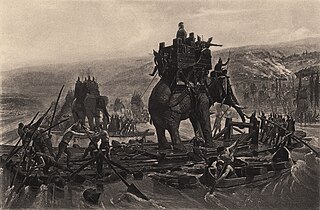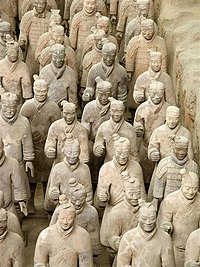3rd century BC: Difference between revisions
m →Decades and years: WP:CHECKWIKI error fixes + general fixes using AWB (7968) |
→270s BC: fixed minor error on Ashoka's rule end date |
||
| Line 34: | Line 34: | ||
*After failing to decisively defeat the Romans, [[Pyrrhus of Epirus]] withdraws from Italy. |
*After failing to decisively defeat the Romans, [[Pyrrhus of Epirus]] withdraws from Italy. |
||
*[[Gauls|Gallic]] migration to [[Macedon]], [[Thrace]] and [[Galatia]]. |
*[[Gauls|Gallic]] migration to [[Macedon]], [[Thrace]] and [[Galatia]]. |
||
*273 BC – |
*273 BC – 232E BC: [[Ashoka the Great]] ruled the [[Mauryan Empire]]. |
||
===260s BC=== |
===260s BC=== |
||
Revision as of 16:37, 1 March 2012
| Millennium |
|---|
| 1st millennium BC |
| Centuries |
| Timelines |
| State leaders |
| Decades |
| Categories: |
|
Births – Deaths Establishments – Disestablishments |

The 3rd century BC started the first day of 300 BC and ended the last day of 201 BC. It is considered part of the Classical era, epoch, or historical period.

Overview
The first few decades of this century were characterized by a balance of power between the Greek Hellenistic kingdoms in the east, and the great mercantile power of Carthage in the west. This balance was shattered when conflict arose between Carthage and the Roman Republic. In the following decades, the Carthaginian Republic was first humbled and then destroyed by the Romans in the first and second Punic wars. Following the Second Punic War, Rome became the most important power in the western Mediterranean.

In India, Ashoka the Great ruled the Maurya Empire. The Pandya, Chola and Chera dynasties of the classical age rule and flourish in the ancient Tamil country. The Xiong Nu were at the height of their power in Mongolia. The Warring States period in China drew to a close, with Qin Shihuang conquering other nation-states and establishing the short-lived Qin dynasty, the first empire of China, which was followed in the same century by the long-lasting Han dynasty. The Protohistoric Period began in the Korean peninsula.
Events

290s BC
- 299 BC: The Samnites, seizing their chance when Rome is engaged on the Lombard plain, start the third Samnite War with a collection of mercenaries from Gaul and Sabine and Etruscan allies to help them.
- 298 BC: The Samnites defeat the Romans under Lucius Cornelius Scipio Barbatus in the Battle of Camerinum, first battle of the Third Samnite War.
- 293 BC: The Chinese State of Qin reduced the threat of the State of Wei and the State of Han with the Qin victory in the Battle of Yique.
- Roman armies penetrate into the heart of the Samnite territory and then capture the Samnite cities of Taurasia, Bovianum Vetus and Aufidena.
- Agathocles, king of Syracuse, assists the Italian Greeks against the Bruttians and supported the Greeks against the Romans.
- Ptolemy gives his stepdaughter Theoxena in marriage to Agathocles, the tyrant of Syracuse (in south-eastern Sicily).
- Ptolemy finally brings the rebellious region of Cyrene under his control. He places the region under the rule of his stepson Magas.
- Bindusara succeeds his father Chandragupta Maurya as emperor of the Mauryan Empire.
- Theater, Epidauros, is built with later additions.
280s BC
- 281 BC: Antiochus I Soter, on the assassination of his father Seleucus becomes emperor of the Seleucid empire.
- 280 BC: King Pyrrhus of Epirus invades Italy in an attempt to subjugate the Romans and bring Italy under a new empire ruled by himself.
- 280 BC: Construction of the Colossus of Rhodes is completed
270s BC
- 279 BC: Singidunum and Taurunum, today's Belgrade and Zemun, is founded by Scordisci Celts.
- 275 BC: end of history of Babylon.
- After failing to decisively defeat the Romans, Pyrrhus of Epirus withdraws from Italy.
- Gallic migration to Macedon, Thrace and Galatia.
- 273 BC – 232E BC: Ashoka the Great ruled the Mauryan Empire.
260s BC
- 264 BC: First Punic War breaks out between the Carthaginian Empire and the Roman Republic.
- 261 BC: Antiochus II Theos, 2nd son, at the death of his father becomes emperor of the Seleucid empire.
- 260 BC: Battle of Changping between the State of Qin and the State of Zhao in China; a decisive Qin victory.

250s BC
- 258 BC: An Dương Vương overthrows the Hồng Bàng Dynasty in Viet Nam.
- 257 BC: Thục Dynasty takes over Viet Nam.
240s BC
- 241 BC: First Punic War ends in Carthaginian defeat. Rome demands large reparations, and annexes Sicily and Corsica.
230s BC
220s BC
- 227 BC: The assassination against Ying Zheng, king of Qin State, by Jing Ke from Yan failed.
- 225 BC: A large Gallic army is defeated by the Romans at the Battle of Telamon.
- 225 BC: The Chinese Qin State conquers Wei.
- 223 BC: The Chinese Qin State conquers Chu.
- 222 BC: The Chinese Qin State conquers Yan and Zhao.
- 221 BC: With the conquest of the State of Qi, Qin Shihuang unifies the whole of China into one empire that also included northern Vietnam, forming the Qin Dynasty.
210s BC
- 218 BC: Second Punic War begins. Hannibal makes his famous Alpine crossing to invade Italy, the Roman heartland.
- 216 BC: Hannibal famously crushed the Roman legions at the Battle of Cannae.
- 214 BC: Qin Shi Huang of the Chinese Qin Dynasty ordered construction of the Great Wall of China.
200s BC
- 208 BC: Zhao Tuo (Triệu Đà) defeats the Vietnamese king An Dương Vương.
- 207 BC: Triệu Dynasty of Viet Nam is inaugurated.
- 206 BC – 202 BC: Civil war of the Chu-Han contention in China after the fall of the Qin Dynasty.
- 202 BC: Romans defeat Carthaginians, ending the Second Punic War. Carthage's territories are reduced to the city itself, and crippling reparations are demanded by Rome.
- Indian traders regularly visited Arabia.
- Scythians occupy Sogdiana, in modern-day Uzbekistan.
- Han Dynasty of China was founded (202 BC–220 AD).
- The Pharos of Alexandria is built.
- Appearance of the Hopewell culture in Ohio, USA.
- Teotihuacán, Mexico begun.
Significant persons
- Mencius, Chinese philosopher and sage (371–289 BC)
- Euclid, geometer (c. 365–275 BC)
- Qu Yuan, Chinese poet and scholar from State of Chu (340–278 BC)
- Ilamcetcenni, Cholas ruler of South India in Sangam Age around 301 BC.
- Han Fei, Chinese philosopher from State of Han (280–233 BC)
- Ashoka, Mauryan ruler of India (273 BC–232 BC)
- Archimedes of Syracuse, mathematician, physicist, and engineer (c. 287–212 BC)
- Eratosthenes (c. 276–194 BC), Greek mathematician, geographer and astronomer
- Apollonius of Perga, mathematician (c. 262–190 BC)
- Qin Shi Huang, Chinese Emperor (259–210 BC, reigned 246–210 BC)
- Emperor Gaozu of Han, founder of the Han Dynasty in China, (256 BC–195 BC, reigned 202 BC–195 BC)
- Xiang Yu (232 BC–202 BC), Chinese rebel general against the Qin Dynasty and arch nemesis of Liu Bang in the Chu-Han contention.
- Hannibal, military leader of Carthage (247–182 BC)
- the "second" Brennus, Gaulish chieftain, invades Macedonia in 279 BC
- The Ptolemaic dynasty rules Egypt
- Ptolemy I Soter (305 BC–282 BC) and his wives Eurydice and
- Ptolemy II Philadelphos (284 BC–246 BC) and his wives Arsinoe I and Arsinoe II Philadelphos
- Ptolemy III Euergetes I (246 BC–222 BC) and his wife Berenice II
- Ptolemy IV Philopater (222 BC–204 BC) and his wife Arsinoe III
- Ptolemy V Epiphanes (204 BC–180 BC) and his wife Cleopatra I
- Appius Claudius Caecus, Aqua Appia, Via Appia, invented letter G
- Arcesilaus, founder of new Academy
- Manetho, wrote History of Egypt
- Xun Zi, founder of Legalism (philosophy)
- Zeno of Citium, founder of Stoicism
- Bai Qi, Chinese general
- Song Yu, Chinese poet
- Apollonius of Rhodes, author of Jason and the Argonauts
Inventions, discoveries, introductions
- Eratosthenes accurately calculates diameter of the Earth.
- Weiqi well-established in China, and may date back to the 2nd millennium BC.
- Stone of Canopus (for Ptolemy III), No. 1, in Rosetta Stone Series of 3 stones. Implements Leap year in Egypt. Leap year not formally recognized until Caesar in 55 BC.
- 293 BC: first Roman Sundial [Pliny (79ce): Natural History 7.213].
- Water screw invented by Archimedes.
- Invention of the musical instrument hydraulis, the precursory to the Pipe organ by Ctesibius, a Greek engineer working in Alexandria.
- Emperor Gaozu of Han China discovers an elaborate mechanical puppet theater in the treasury of the previous ruler Qin Shihuang.
- The enormous Du Jiang Yan Irrigation System of China is engineered and constructed by Li Bing in 256 BC.
- Burial chamber, Tomb of the Reliefs, Cerveteri, is made.
- Great Stupa, Sanchi, Madhya Pradesh, India, Maurya period, is founded by King Ashoka.
- Silk is exported to Europe from China.
- Armillary spheres, models of objects in the sky developed by the Greeks, are in use as teaching tools.
Evidence
Much of what is known of this century comes from the works of the Roman historian Polybius, whose main concern is the story of how Rome comes to dominate the known world.
